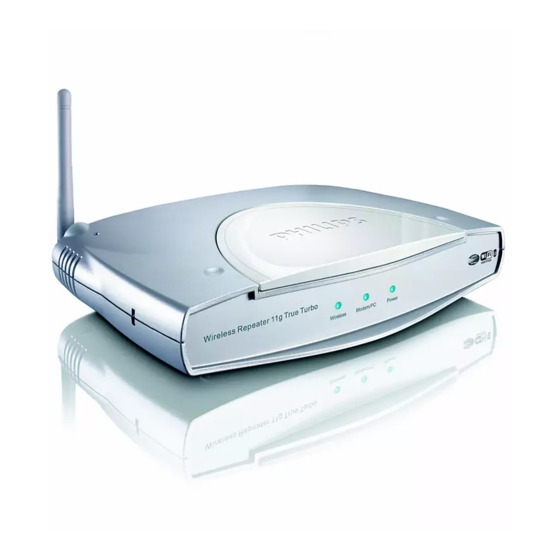Table of Contents
Advertisement
Quick Links
Download this manual
See also:
User Manual
Advertisement
Table of Contents

Summary of Contents for Philips SNR6500
- Page 1 Philips Model Name: SNR6500 Arcadyan Model Name: WA4001C-LF-B7 Wireless Repeater 11g True Turbo Quick Installation Guide...
-
Page 2: Led Indicators
Contents Wireless Repeater BOUT THE Congratulations on your purchase of the IEEE 802.11g Wireless Router. The SNR6500 is a powerful yet simple communication device for connecting your local area network (LAN) to the Internet. LED Indicators The IEEE 802.11g Wireless Repeater includes status LED indicators, as described in the following figure and table. -
Page 3: Package Contents
missing or damaged, contact your local distributor. Also be sure that you have all the necessary cabling before installing the Wireless Repeater. After installing the Wireless Repeater, refer to the web-based configuration program in “Configuring the IEEE 802.11g Wireless Repeater” on page 20 for information on configuring the Wireless Repeater. -
Page 4: System Requirements
Figure 1. Front and Rear Panels System Requirements • Internet access from your local telephone company or Internet Service Provider (ISP) using a DSL modem or cable modem. • A PC using a fixed IP address or dynamic IP address assigned via DHCP, as well as a gateway server address and DNS server address from your service provider. - Page 5 1. Connect the LAN: Connect the Wireless Repeater to your PC, or to a hub or switch. Run Ethernet cable from one of the LAN ports on the rear of the Wireless Repeater to your computer’s network adapter or to another network device. You may also connect the Wireless Repeater to your PC (using a wireless client adapter) via radio signals.
-
Page 6: Configuring Your Computer In Windows 2000
ONFIGURING TCP/IP LIENT To access the Internet through the Wireless Repeater, you must configure the network settings of the computers on your LAN to use the same IP subnet as the Wireless Repeater. The default network settings for the Wireless Repeater are: Router IP Address: 192.168.1.3 Subnet Mask: 255.255.255.0 Configuring Your Computer in Windows 2000... -
Page 7: Configuring Your Computer In Windows Xp
2. In the Command Prompt window, type ipconfig /release and press the Enter key. 3. Type ipconfig /renew and press the Enter key. Verify that your IP Address is now 192.168.2.xxx, your Subnet Mask is 255.255.255.0 and your Default Gateway is 192.168.2.1. These values confirm that the Wireless Repeater is functioning. -
Page 8: Verifying Your Tcp/Ip Connection
Manual IP Configuration (for all Windows OS) 1. Check Specify an IP address on the IP Address tab. Enter an IP address based on the default network 192.168.2.x (where x is between 2 and 254), and use 255.255.255.0 for the subnet mask. 2. -
Page 9: Browser Configuration
default gateway must be 192.168.2.1. If you can successfully ping the Wireless Repeater you are now ready to connect to the Internet! WIRELESS ONFIGURING THE REPEATER The IEEE 802.11g Wireless Repeater can be configured by Internet Explorer 5.5 or above. Using the web management interface, you can configure the Wireless Repeater and view statistics to monitor network activity. -
Page 10: Making Configuration Changes
Use the Setup Wizard if you want to quickly set up the Wireless Router for use with a cable modem or DSL modem. Making Configuration Changes Configurable parameters have a dialog box or a drop-down list. Once a configuration change has been made on a page, be sure to click the APPLY or NEXT button at the bottom of the page to enable the new setting. - Page 11 Connect Mode • Always On Line: If you enable this, idle time is not taken into account. The connection will always be alive. • Manual Connect: When the connection is broken by the idle time, you must press Connect button on the Status page to reconnect.
- Page 12 Advanced setup supports more advanced functions like hacker attack detection, IP and MAC address filtering, intrusion detection, virtual server setup, virtual DMZ hosts, and other advanced functions. Please refer to Advanced Management Guide included in the documentation CD for details. Model Number: SNR6500...
-
Page 13: Fcc Regulations
FCC Regulations: This device complies with part 15 of the FCC Rules. Operation is subject to the following two conditions: (1) This device may not cause harmful interference, and (2) this device must accept any interference received, including interference that may cause undesired operation. This device has been tested and found to comply with the limits for a Class B digital device, pursuant to Part 15 of the FCC Rules.








